The MacBook Pro Review (13 & 15-inch): 2011 Brings Sandy Bridge
by Anand Lal Shimpi, Brian Klug & Vivek Gowri on March 10, 2011 4:17 PM EST- Posted in
- Laptops
- Mac
- Apple
- Intel
- MacBook Pro
- Sandy Bridge
Thermals and Power Consumption
The new MacBook Pros have the potential to draw more power than the previous generation. Despite being built on a 32nm process, the new 15 has twice the cores of last year's model—there's no question that it can draw more power under a full load.
I measured maximum power consumption at the wall using the same power brick and a fully charged battery. I chose two high-load scenarios: Cinebench 11.5 and Half Life 2. The former will fully load all CPU cores while the latter ramps up CPU and GPU usage.
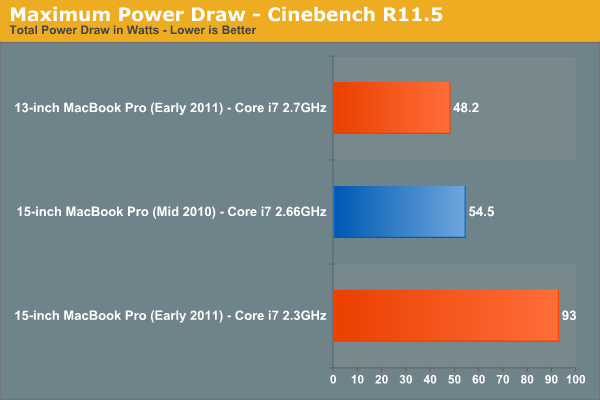
Under Cinebench the new quad-core 15-inch MacBook Pro draws 70% more power at the wall than last year's dual-core model. This shouldn't be surprising as Cinebench scales nearly perfectly with core count—twice the cores should result in nearly twice the power draw. The scaling isn't perfect since we are dealing with different architectures and a number of factors such as display remain static. The new 13-inch MacBook Pro isn't as worrisome, it has 88% of the power usage of the high end 2010 15-inch MBP and 81% of the battery capacity.
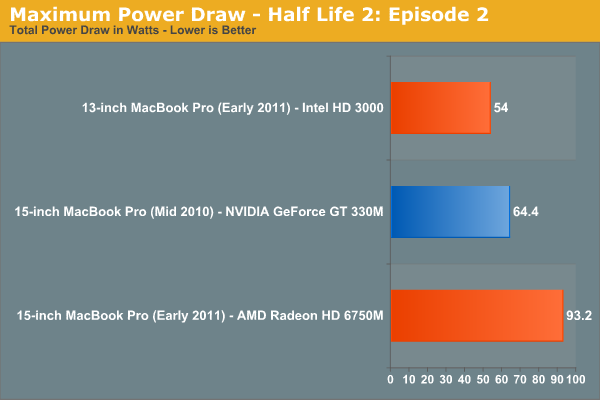
The Half Life 2 comparison is not quite as bad, although the new 15-inch MBP still uses 45% more power under full load compared to the previous generation. These numbers tell you one thing: although the new MBP is significantly faster than its predecessor, it can also draw significantly more power. Running the same workload the new MBP shouldn't have any problems lasting as long as the old MBP on battery, but running a more aggressive workload will result in shorter battery life as a result of the higher max power consumption. In other words if you use the higher performance to do more, you can expect your battery to last proportionally less than the 2010 MBP.

The 15-inch MBP uses an 85W power adapter (left) and the 13-inch MBP uses a 60W adapter (right)
Drawing more power also has another unfortunate side effect: the bottom of the chassis gets even hotter than before. I took some crude temperature measurements when I did the 2010 MacBook Pro reviews last year. I pointed an IR thermometer at the center of the bottom of the notebook, right where you'd have your lap, and measured surface temperature in a couple of scenarios.
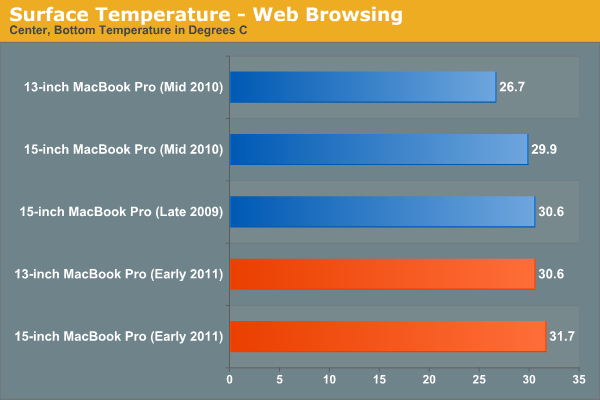
While browsing the web with tons of windows/tabs open I noticed a small but tangible increase in surface temperature of the 2011 15-inch MBP compared to the 2010 model. Even the new 13 is warmer than last year's 15. Under light workloads none of these temperatures are high enough to really be a problem.
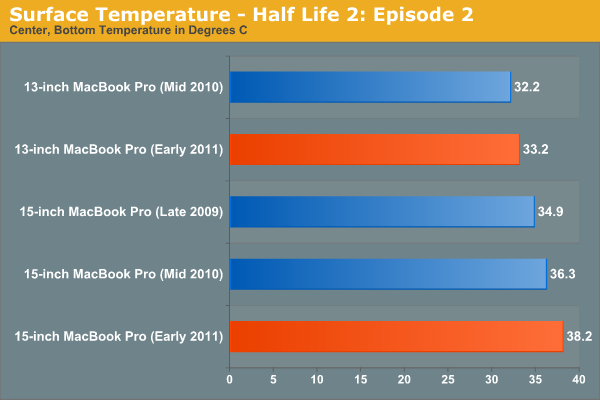
Load up the system however and you start getting into the uncomfortable zone. The new 15 breaks 38C, while the new 13 is actually only marginally warmer than the old 13 thanks to the use of Intel's HD Graphics 3000.
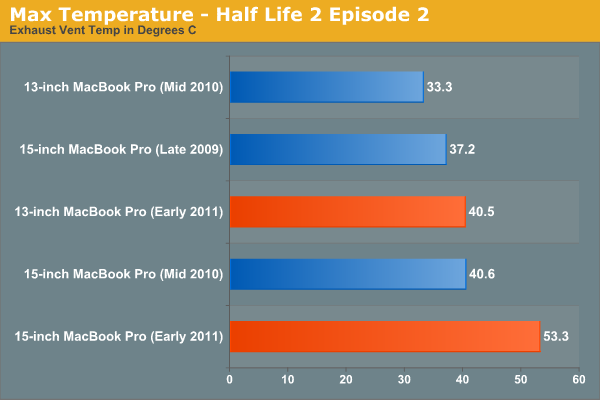
The biggest difference I noticed was the max temperature near the exhaust fan(s) on the notebooks. The new 15 is a whole 13C warmer than last year's model.
There's no way to get around it—if you're going to be using these systems to anywhere near their potential, they are going to get significantly warmer than last year's. Also, as a result, the new systems are noisier. Fans are more likely to spin up and given how small they are, they are quite audible. If this is a deal breaker for you, the best advice I can give you is to wait for Ivy Bridge.

Ivy Bridge will bring mild updates to the Sandy Bridge architecture, an increase in performance but more importantly it'll bring Intel's 22nm process. At 22nm I'd expect somewhat lower power usage than what we're seeing here today. Ivy Bridge is expected to ship in the first half of 2012, with updated MacBook Pros arriving ~2 months post introduction.










198 Comments
View All Comments
brettski - Thursday, November 10, 2011 - link
Total NYC sales tax is 8.875%.NY state tax is only 4.5%
brettski - Thursday, November 10, 2011 - link
i'm sorry... state is 4%, city is 4.5%, plus Metropolitan Commuter Transportation District surcharge of 0.375%= 8.875% sorry... mixed up the city and state rates.gstrickler - Thursday, March 10, 2011 - link
What are you talking about? Most of us non-gamers don't even need a dedicated GPU, much less 256MB of graphics memory. I'm currently running on a late 2007, 15" MBP which has an 8600M GPU with 128MB of graphics RAM, and I only use it because there is no IGP on this machine. Once you get to the level of the Nvidia 9400M, IGP is plenty for a non-gamer, and even 32MB allocated to graphics RAM is more than adequate. The exception is if you need OpenCL support, since Intel's IGPs don't support OpenCL.I wish Apple offered a 13" MPB with a higher resolution (1440x900) matte display or a 15" with AES-NI and without a dGPU. I could use the faster CPU and HT, but I don't really need quad-core (but it's nice to have it available when on AC power), and battery life is far more important to me than a GPU or maximum CPU speed.
In fact, what I would really like is a 15" with matte display, no dGPU, Core i7-2720QM (for AES-NI support) with the ability to disable 2 cores/4 threads when on battery power. The 2011 15" lets me get close, if I use gfxcardstatus to disable the dGPU. If I can get software to disable 2 cores when on battery, it'll give me everything I'm asking for, but at a fairly hefty premium ($+150 for the matte display, $+400 for the Core i7-2720QM and Radeon 6750M + 1GB that I'll never use). Of course, what that means is that I'll either get the entry level 15" without AES-NI support and use gfcardstatus to disable the dGPU, or I'll wait for the next update and see if the options are any better.
Notes to Apple:
1. Make a matte screen an option on all machines, for no more than a $50 premium (no forced upgrade to a higher resolution)
2. Offer a 15" without a dGPU (e.g. make the dGPU a separate plug-in module)
3. Offer a 1440x900 screen for the 13" MPB.
I doubt I'll see any of those, but it doesn't hurt to ask.
tipoo - Thursday, March 10, 2011 - link
"Most of us non-gamers don't even need a dedicated GPU"Most people don't need a truck, that doesn't mean no one does. This is branded as a pro machine, and at nearly 2 grand the GPU doesn't fit the bill.
alent1234 - Friday, March 11, 2011 - link
MAcbooks are thin, long battery life, nice screen and good build quality first. specs second. until sandy bridge came out laptops with long battery life cost just as much as a macbook or more.a lot of the people that buy these are mobile pro's who need to use a laptop for hours while away from a power source
sync216 - Thursday, March 10, 2011 - link
256MB is fine for the 64xxM series GPUs. The performance improvement going to GDDR5 and a faster GPU is much higher than the improvement from 256 to 512 would have given. For customers who really need the additional graphics performance (and corresponding graphics memory) apple is offering the very fast 6750M with 1GB.Demon-Xanth - Thursday, March 10, 2011 - link
...Apple is more like Sony than Acer? Their core buisness is no longer computers, but gadgets.michael2k - Friday, March 11, 2011 - link
Um, this was evident in 2001 when the Titanium PowerBook was first unveiled, then the iPod later that year, then the music store in 2004, etc.Also, you have it backwards, their core business is computers, they just happen to know how to turn computers into gadgets. They treat the iPod like a computer (firmware updates on a regular basis), which means they aren't disposable. Contrast that to the average phone OEM with Android who won't see updates for longer than 6 months, where Apple pushes updates to their iPhone for over 29 months.
jameskatt - Friday, May 6, 2011 - link
Nearly all of Apple's products are computers:Mac Pro = desktop expandable computer running OS X
iMac = all-in-one desktop computer running OS X
Mac Mini = non-expandable desktop computer running OS X
MacBook Pro = high end laptop computer running OS X
MacBook Air = high end netbook computer running OS X
MacBook = basic laptop computer running OS X
iPad = tablet computer running OS X
iPhone = handheld tablet computer with phone running OS X
iPod Touch = handheld tablet computer running OS X
AppleTV = multimedia appliance computer running OS X
OS X has two variations - Mac OS X and iOS. The core operating system is the same for both.
Apps for both are written using Apple's XCode Development System.
quiksilvr - Thursday, March 10, 2011 - link
I'm surprised SSD isn't standard to begin with. $1199 for a 13" laptop and you don't even get dedicated graphics? Seriously? The HDDs aren't even 7200rpm. This is insulting to the nth degree.If you want a solidly built, well-spec'd, thin and fairly priced system, get the Envy 14. You get 7200rpm HDD, dedicated graphics, an HD webcam with TWO microphones (necessary for sound cancelling), a backlit keyboard and even Photoshop and Premiere.
Until Apple drops their prices to a realistic and reasonable level, avoid it completely.